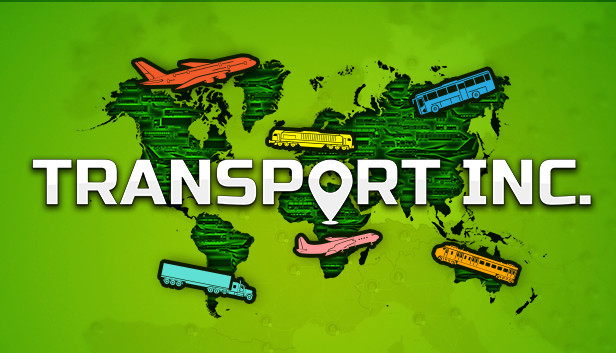Transport Inc. is a management tycoon game that places you in the role of CEO of a large transportation corporation. It is your job to develop a profitable transport system that consists of buses, trains, and planes. You have to determine the most profitable routes – accounting for variables such as demand for comfort, length of trip, travelling speed, and even what your opponents are doing. Overall, Transport Inc. is a game that fits right into the business building niche and is a fresh look at casual management gaming. For more information check out our Transport Inc Review.
This guide will go over some of the best tips to get started in building your own transport conglomerate!
Tip #1: Start with multiple buses instead of trains
It is tempting to take out a big loan at the start of the game and buy the license to use trains. Unfortunately, this usually leaves you with very little cash flow and extremely slow growth. Start off with multiple small buses that run between small cities to maximize growth and minimize need to reduce ticket price.
This method is also great to min-max your early game profit since you can pin-point exactly how much transportation is needed to satisfy all of the routes from a city. If you are a new player, this method gets you used to the idea of which buses are the best for which types of cities.
Tip #2: Use a manager once you have 7-8 buses
A bus manager currently costs $25,000 to start using and needs $25,000 to set up the first depot. For a brand new playthrough, $50,000 is a hefty chunk of cash that is much better used to build more buses. It is usually manageable to manually select which buses to repair if you only have around 8-9 buses running.
Also consider the fact that your buses will take quite some time before they really need to be repaired. There is no need to even build the depot until the buses are partly damaged – much less purchasing an office for the manager. The micromanagement of repairs does not become problematic until you have 10-12 buses running in various locations.
Use the cash you currently have to invest in the best possible opportunity in front of you – more buses!
Tip #3: Micromanage ticket prices for new routes
Until you are extremely comfortable with knowing what prices work with which types of buses between which cities, definitely micromanage the ticket price for the first few trips. This is one of the best ways to improve your profitability. Whenever you buy a new bus, estimate what a good price is by comparing the number of stars to the size of cities it is moving between. Typically anything lower than 2 stars should have a lower ticket price if even one of the destinations is larger than a small city. Make sure to do this for both the regular passenger and the high-paying passengers.
If you do not usually like micromanaging prices, consider how much of an impact even 1-2 dollars makes on overall profitability. The price of the ticket is per passenger per 100km – once you mutliply that out by the dozens of passengers you have, it becomes a significant number. This is especially important when you purchase large vehicles that transport a large number of people or goods – remember that each dollar is multiplied multiple times!
Tip #4: Use appropriate buses for the large cities
It is much more profitable to actually use the right buses to transport people between large cities. These routes typically require a higher star rating and a faster speed. If you try to use a low-tier bus that travels slowly, you will end up having to reduce ticket price so much that you could even come close to losing money per trip. You have to either choose the right bus or choose a different route for your investment to make sense.
In the opposite situation, if you choose to use a fancy bus between small cities, make sure you increase the price substantially to account for the cost of the bus. It is okay to use a more comfortable bus in these situations, but they are honestly better used in large cities since the possible profit is higher.
Tip #5: Take out loans in Week 1 and avoid interest above 12%
It might not seem like a big difference, but the extra 3 weeks could potentially save you a ton of money by avoiding interest. If you take out the loan right after the month starts, this gives you the full month to start making money before your first payment. In comparison, taking your loan out in Week 4 means you immediately have to pay back part of the loan with interest.
Keep in mind that this tip depends on your ability to pay off the loan early. If you don’t plan to do so, then you can ignore this tip. I do recommend paying it off early though, since many of the loans are in the range of around 15% – which adds up substantially over time.
The 12% number is just an estimate I use to avoid massive interest rates that take forever to pay off. The usual return on interest will be higher than that 12% as long as you micromanage the ticket price as mentioned above. Feel free to experiment around, but this general rule of thumb has helped me avoid bad loans.
Tip #6: Take out lower interest loans to pay off old loans
This is a function that essentially re-finances your bank loans. Your company will end up paying much less in interest if you constantly monitor for the best possible interest rate.
Keep in mind that in Transport Inc. there is no function to partially pay back a loan. If you plan to take out a new loan to pay off the old one, make absolutely sure that you can loan enough to actually pay it off.
Another tip is to take out the largest loan for a max duration if the interest rate is at 8%. This extra cash will definitely help you a ton in ramping up your bus routes and the max duration means you can definitely pay off the loan early and minimize interest.
Tip #7: Do not blindly acquire competitors
Unfortunately, not all of the competitors are smart about placing depots and repair sites. After acquiring a competitor, I quickly found out that their buses don’t always have access to a depot nearby and it has resulted in a ton of broken routes. If you are interested in acquiring a competitor, please try to aim for the one that is near to you. This way the buses can always route to your original depots if need be.
Alternatively, spend some time after the acquisition to ensure that depots are well-built in their area of the map and that all of their buses are under your manager.
These mergers have the potential to skyrocket your profits since you are essentially adding a ton of buses to your arsenal. Just keep in mind that you may have to spend quite a bit of time micromanaging the ticket prices and new routes to ensure that they are profitable for you.
Tip #8: Click on existing cities to explore which area to unlock next
You can see potential routes when you click on your existing cities. This helps you determine which area has the most demand for your transportation. Typically I like to choose the area that has high demand in cities that are connected to your existing area through railroads. Later on in the game, the railroad system is a great way to supply transportation and investigating the potential of the area ensures you are planning for the future.
This tip is also to prevent you from being mislead by other factors like total number of available cities. More cities might not always be more profitable if they don’t have as many routes to connect to your original hub. More cities also means it is more expensive to license – be sure that this is the right investment before purchasing.
Tip #9: Diversify transportation methods and products moved
Transportation Inc. has mechanics like disasters, holidays, and road closures that can have a huge impact on your transportation empire. Diversifying beyond just buses ensures that you have other sources of revenue in case road closures hit your current routes hard.
Likewise, the product that you move (regular population, high-paying population, goods) will also be affected by a variety of game mechanics. Having a good diversity ensures that you will have as many opportunities to benefit from events as possible, while also ensuring that disasters do not wipe out your entire profit.
Tip #10: Remember to develop small routes late game
It is very easy to be tempted to save up a ton of cash to buy a $3 million plane late game. However, all that time that you spent on waiting for money could have been used to develop a lot more of the smaller routes. These routes individually may not have as much of an impact on your profitability, but developing $3 million worth of them definitely will.
Once you consistently get around $200,000 to $300,000, make a mental note to slow yourself down and re-evaluate all of your current cities. Building a small route to transport 50 people between two cities might not sound like a lot, but every single bit of profit counts.
Also keep in mind that there are very few large routes that are actually available – the vast majority of opportunities are still medium sized routes that only move around 80-90 people at once. Don’t lose sight of all of these opportunities and you will be able to reach expensive vehicles even sooner.
Tip #11: Avoid overfilling routes
Just because the route says there are 100 people needing transportation does not mean that you should place two 50-person buses on that route. It takes time for the population regenerate and placing two buses on this route will just result in wait unnecessary wait times.
Maximize your profit by approximating how quickly the demand replenishes and add/subtract buses to ensure they do not wait at all at either end.
Tip #12: Damage expensive competitor vehicles and close their roads
Once you are consistently making a few hundred thousand dollars a month, take the time to analyze your opponents and identify which routes are most commonly used. Transport Inc. allows you to use nefarious methods to gain an advantage. The most potent of these is the ability to close roads. When used properly, you can very literally put a stop to your competitor’s entire empire. Sure there are a few small routes here and there, but I have found that a lot of the routes your opponents use actually end up overlapping at certain sections.
Likewise, damaging their most expensive vehicle will not only force them to pay for repairs, but will also delay their profits. This slows down their growth and allows your own company to gain the advantage. Destroying enemy vehicles is usually a more expensive option, but you almost always end up coming out ahead once you take into account their lost profits.
Tip #13: Complete the Story Mode
Many players I know like to skip tutorials in management games, but I heavily recommend you all finish the Story mode for Transport Inc. It is actually a very well thought-out tutorial that keeps you intrigued the entire way. The missions are approached in a step-wise manner that slowly adds more features as you move forward. By the time you get to the end, you will have learned how to play the game to its fullest degree.
The pacing of the story is also great since it lets you take time to complete the mission, but also adds a slight pressure since you have competitors that you have to beat. It also locks some features initially so that you do not get overwhelmed and fall into early traps.
One final benefit about the Story Mode is that it places you in different parts of the world with different cities and settings. This gives you a chance to develop skills in analyzing where to expand, instead of just doing the same thing over and over again.
Conclusion
Transport Inc is a fantastic business management game that really scratches that Tycoon itch. It is a great combination of casual gameplay and opportunities for micromanagement. I hope that this guide has been of some help in giving you a smoother start to the game.
Thank you very much for reading and please comment below if you have any questions or feedback! Check out our Transport Inc Review to see if this game is for you.
Follow us on Twitter here to stay up to date with our guides and reviews for strategy and management games.





Pingback: Transport Inc. Review - Kijin Gaming